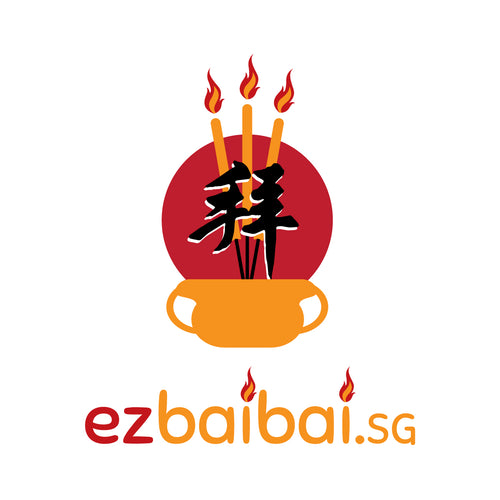The Generational Significance of Qingming Festival
Qing Ming Festival is one of the most important traditional festivals for the Chinese community in Singapore. Every year during this time, descendants honor their ancestors through tomb sweeping, offering sacrifices, and other rituals to express gratitude and remembrance. Burning joss paper is one of the key rituals during Qing Ming, and it not only conveys blessings to the deceased but also continues the family culture and traditional filial piety.
Cultural Background of Qing Ming Festival
Qing Ming Festival has a history of over two thousand years, dating back to the Spring and Autumn period. According to the "Jingchu Suishiji," it is recorded: "All things grow at this time, and everything is clean and bright, hence it is called Qing Ming." This day is both a time to remember ancestors and a time to be close to nature and feel the arrival of spring. The customs of Qing Minginclude tomb sweeping, ancestor worship, spring outings, and willow branch prayers, with tomb sweeping and ancestor worship being the core activities.
Types of Joss Paper and Their Meanings
During Qing Ming, joss paper was more than just an offering; it is a form of cultural transmission. Different types of joss paper carry different meanings and are used in various contexts:
-
Silver and Gold Paper: Gold paper symbolizes wealth, while silver paper represents peace. Burning these papers is a common way to pray for wealth and peace for the ancestors' spirits.
-
Paper Ingots (Yuanbao Paper): Shaped like gold ingots, they symbolize wealth and good luck. Burning paper ingots is believed to send "money" to the deceased, helping them live well in the afterlife.
-
909 Joss Paper (特级古力皇银): Bringing abundant prosperity and wealth to ancestors, attracting blessings and fortune, and ensuring continuous financial success.
-
Lotus Flower Paper: Commonly used in Buddhist rituals, lotus flowers symbolize purity and peace. They are suitable for honoring ancestors or Buddhist deities.
-
Paper Offerings (Jia Zha Items): These include paper models of houses, cars, clothes, and other modern items, which are becoming increasingly popular. They symbolize providing for the deceased's needs in the afterlife.
Complete Steps of Qing Ming Tomb Sweeping Ritual
Preparation Before the Ritual
-
Selecting Offerings: Prepare the necessary offerings for Qing Ming, including joss paper, incense, paper ingots, fruits, pastries, wine, etc. The types of offerings may vary by region, but joss paper is an indispensable core item.
-
Choosing the Time: Tomb sweeping usually takes place within three days before or after Qing Ming, depending on family arrangements or local customs.
Upon Arrival at the Cemetery
-
Cleaning the Tombstone: Clear away weeds and dirt around the tomb, and clean the tombstone to keep it neat and tidy. Cleaning the tomb is not only a sign of respect for the deceased but also expresses filial piety and care from the descendants.
Placing the Offerings
-
Arrange the offerings (such as fruits and pastries) in front of the tombstone. The number of offerings is usually in even numbers, symbolizing harmony and balance.
Burning Joss Paper and Paper Ingots: Place joss paper and paper ingots aside to burn later.
Respectful Rituals
-
Lighting Incense and Offering Prayers: Light the incense and offer prayers in sequence. The eldest will lead the family in paying respects, and younger members follow. This is a gesture of respect and well-wishing to the ancestors.
-
Prayer: During incense offering, you may silently pray for wishes like family peace, career success, etc., to convey your thoughts to the ancestors.
Burning Joss Paper
-
Burn joss paper and paper ingots in order, starting with silver and gold paper, followed by paper ingots, and finally longevity paper.
While burning, you may call out the names of the ancestors to express specific blessings and prayers, giving the ritual clear meaning.
Sharing Family Memories
-
After the burning ritual, families often share stories about their ancestors, recounting the family’s history. This not only strengthens family bonds but also helps the younger generation understand the family’s traditions and values.
Cleaning Up
Before leaving, gather the ashes of the burnt offerings and take away any trash, leaving the cemetery tidy.
Other Traditional Customs of Qing Ming Festival
-
Spring Outings (Taqing): As Qing Ming marks the arrival of spring, many people go on spring outings during the festival. After tomb sweeping, families often go for a walk in nature to relax and rejuvenate, drawing strength from the season of renewal.
-
Inserting Willow Branches for Protection: Folk traditions believe that Qing Ming is a special time when the boundary between the living and the dead is thin. Inserting willow branches in front of the house is believed to ward off evil spirits, and the willow tree symbolizes resilience and hope.
-
Making Seasonal Foods: Qing Ming is also a time for making traditional foods such as green dumplings (Qingtuan) and spring rolls (Runbing). The green color of Qingtuan symbolizes the vitality of spring, and Runbing represents family unity, making them a classic delicacy for the festival.
Qing Ming Festival is not only a time for honoring ancestors but also a moment for passing down filial piety and strengthening family bonds. Through carefully selecting joss paper and offerings, and performing each step of the tomb sweeping ritual with sincerity, we can better express our gratitude and remembrance for our ancestors.
If you have any questions about choosing joss paper or need specific combinations of offerings, feel free to visit our store. We offer a wide range of high-quality joss paper and traditional offerings, providing you with the best service to help you honor and pray for your ancestors.
This Qing Ming Festival, let us use joss paper to send our thoughts and blessings to our loved ones on the other side.















